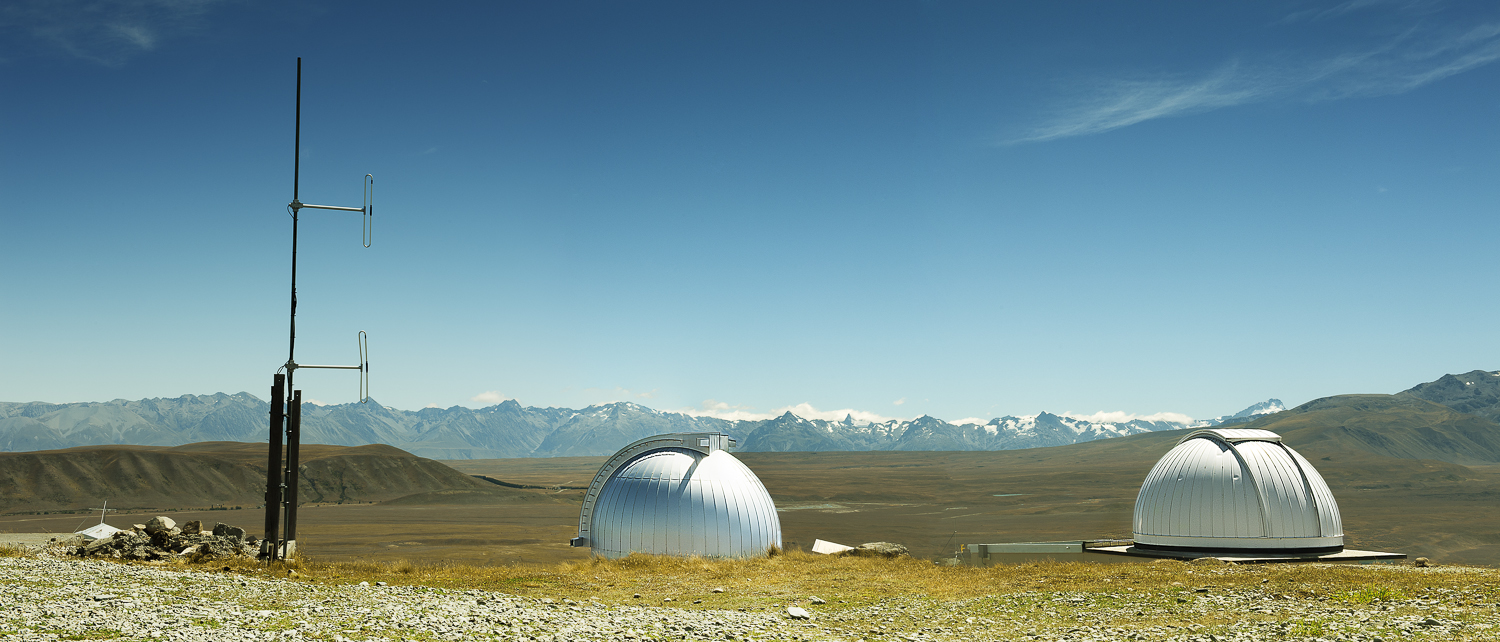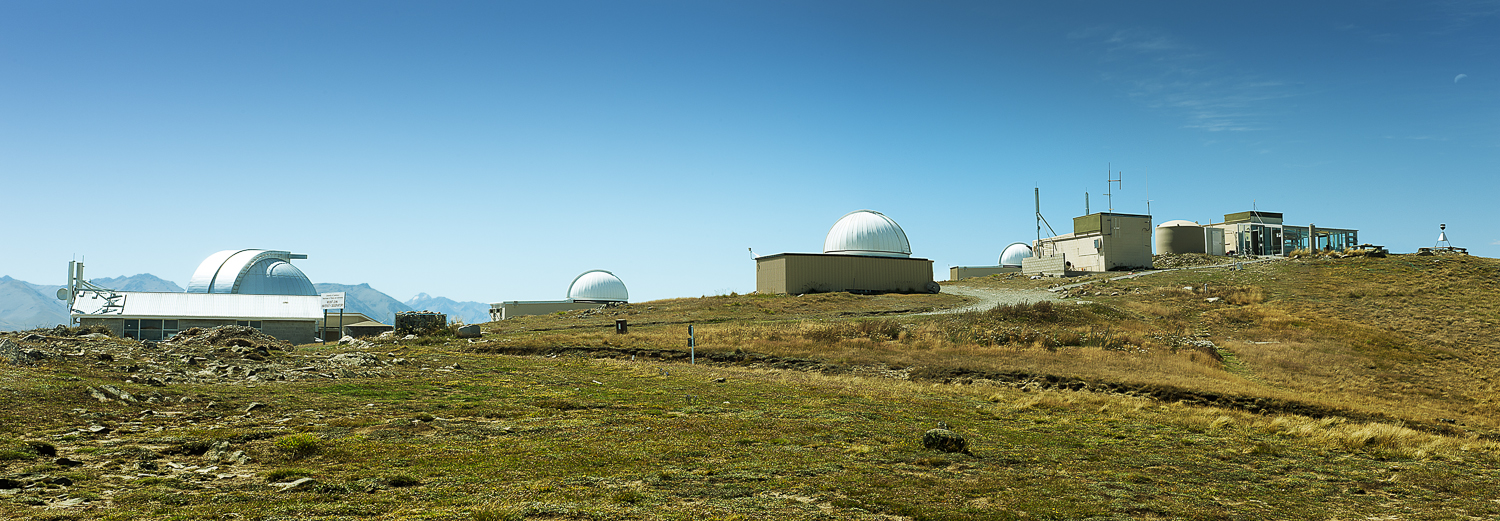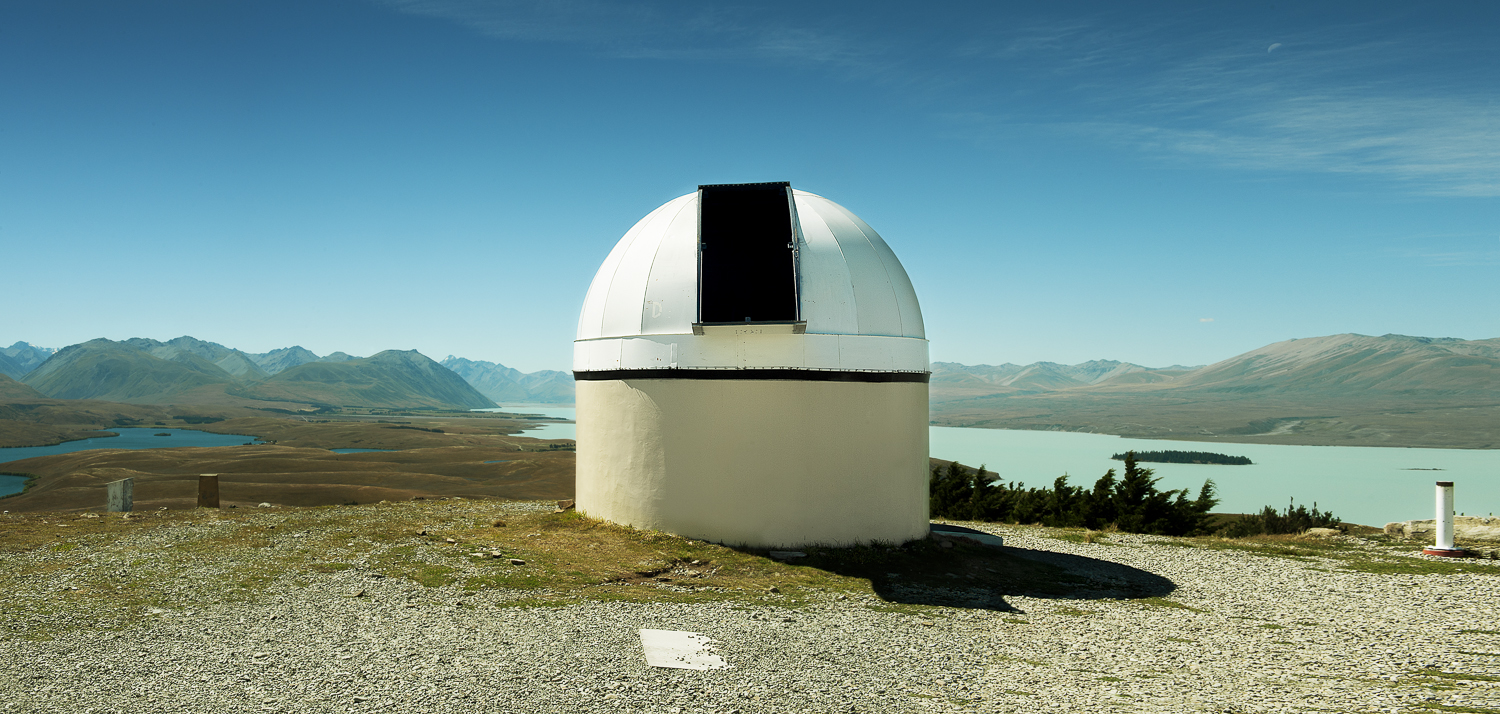
Mount John University Observatory (MJUO), NZ

Mount John University Observatory (MJUO), NZ

Mount John University Observatory (MJUO), New Zealand

Mount John University Observatory (MJUO), NZ

Mount John University Observatory (MJUO), NZMount John University Observatory (MJUO), is New Zealand's premier astronomical research observatory.[1] It is situated at 1,029 metres (3,376 ft) ASL atop Mount John at the northern end of the Mackenzie Basin in the South Island, and was established in 1965.[1] There are many telescopes on site including: one 0.4-meter, two 0.6-meter, one 1.0-meter, and a new 1.8-meter "MOA Telescope" (see details below). The nearest population center is the resort town Lake Tekapo (pop. <500). Approximately 20% of nights at MJUO are photometric, with a larger number available for spectroscopic work and direct imaging photometry.MJUO is operated by the University of Canterbury, and is the home of HERCULES (High Efficiency and Resolution Canterbury University Large Echelle Spectrograph), and the observational wing of the Japanese/New Zealand MOA collaboration (Microlensing Observations in Astrophysics) led by Professor Yasushi Muraki of Nagoya University. A Japanese funded, 1.8-meter telescope is now in place and will be used initially by the MOA Project, before handover to the University of Canterbury at the conclusion of the MOA Project in 2012.In June 2012 an area of 430,000 hectares (1,700 sq mi) around the observatory was declared as the Aoraki Mackenzie International Dark Sky Reserve by the International Dark-Sky Association, one of only four such reserves around the world.[2] The area has a Bortle Scale of 2.[3]There are 5 large telescopes on the mountain that are in regular use. There is also a cafe and night-tours run by tourist operators, Earth and Sky. There is accommodation for visiting researchers within the 1.0m building. A Superintendent lives on the mountain.MOA Telescope[edit]Opened in 2004 December, this telescope was built by Japanese astronomers and is dedicated to the MOA project. It is a 1.8m prime focus reflector. The MOA telescope is the largest telescope in New Zealand.McLellan Telescope[edit]This is a 1.0m Dall-Kirkham reflecting telescope run at either f/7.7 or f/13.5. Photometric imaging is by CCD camera and spectroscopy is by fibre-optic cable to the HERCULES spectrograph.Boller & Chivens Telescope[edit]This is a 0.61m reflecting telescope run at either f/13.5 or occasionally f/6.25. Photometry is usually carried out using an Apogee Alta CCD camera.Optical Craftsmen Telescope[edit]This is a 0.61m fork mounted reflecting telescope operating at f/16. This telescope is used exclusively for CCD photometry. It is currently being upgraded and commissioned for robotic use as part of the AAVSO's Robotic Telescope Network. This is the AAVSO's first Southern Hemisphere telescope.Earth and Sky Telescope[edit]This telescope, used exclusively for visual tourist operations is a 0.4m Meade LX200 telescope. Stewart Donn Photography.A Melbourne based photographer specialising in all Corporate, Commercial, Industrial and Product photography. Specialising in this type of photography allows Stewart to make complicated corporate and industrial scenes, and the people in these scenes, look heroic, interesting and beautiful.Based in Melbourne’s Western suburbs.Stewart has worked and is comfortable working with, small one to five man companies such as Fundere Artist Foundry in Footscray, through to larger companies such as the Melbourne Convention & Exhibition Centre, Museum Victoria, and Energy Power Systems Australia, and has also worked with Agency’s such as Badjar Ogilvy, One20 and DT Digital.

Mount John University Observatory (MJUO), NZMount John University Observatory (MJUO), is New Zealand's premier astronomical research observatory.[1] It is situated at 1,029 metres (3,376 ft) ASL atop Mount John at the northern end of the Mackenzie Basin in the South Island, and was established in 1965.[1] There are many telescopes on site including: one 0.4-meter, two 0.6-meter, one 1.0-meter, and a new 1.8-meter "MOA Telescope" (see details below). The nearest population center is the resort town Lake Tekapo (pop. <500). Approximately 20% of nights at MJUO are photometric, with a larger number available for spectroscopic work and direct imaging photometry.MJUO is operated by the University of Canterbury, and is the home of HERCULES (High Efficiency and Resolution Canterbury University Large Echelle Spectrograph), and the observational wing of the Japanese/New Zealand MOA collaboration (Microlensing Observations in Astrophysics) led by Professor Yasushi Muraki of Nagoya University. A Japanese funded, 1.8-meter telescope is now in place and will be used initially by the MOA Project, before handover to the University of Canterbury at the conclusion of the MOA Project in 2012.In June 2012 an area of 430,000 hectares (1,700 sq mi) around the observatory was declared as the Aoraki Mackenzie International Dark Sky Reserve by the International Dark-Sky Association, one of only four such reserves around the world.[2] The area has a Bortle Scale of 2.[3]There are 5 large telescopes on the mountain that are in regular use. There is also a cafe and night-tours run by tourist operators, Earth and Sky. There is accommodation for visiting researchers within the 1.0m building. A Superintendent lives on the mountain.MOA Telescope[edit]Opened in 2004 December, this telescope was built by Japanese astronomers and is dedicated to the MOA project. It is a 1.8m prime focus reflector. The MOA telescope is the largest telescope in New Zealand.McLellan Telescope[edit]This is a 1.0m Dall-Kirkham reflecting telescope run at either f/7.7 or f/13.5. Photometric imaging is by CCD camera and spectroscopy is by fibre-optic cable to the HERCULES spectrograph.Boller & Chivens Telescope[edit]This is a 0.61m reflecting telescope run at either f/13.5 or occasionally f/6.25. Photometry is usually carried out using an Apogee Alta CCD camera.Optical Craftsmen Telescope[edit]This is a 0.61m fork mounted reflecting telescope operating at f/16. This telescope is used exclusively for CCD photometry. It is currently being upgraded and commissioned for robotic use as part of the AAVSO's Robotic Telescope Network. This is the AAVSO's first Southern Hemisphere telescope.Earth and Sky Telescope[edit]This telescope, used exclusively for visual tourist operations is a 0.4m Meade LX200 telescope. Stewart Donn Photography.A Melbourne based photographer specialising in all Corporate, Commercial, Industrial and Product photography. Specialising in this type of photography allows Stewart to make complicated corporate and industrial scenes, and the people in these scenes, look heroic, interesting and beautiful.Based in Melbourne’s Western suburbs.Stewart has worked and is comfortable working with, small one to five man companies such as Fundere Artist Foundry in Footscray, through to larger companies such as the Melbourne Convention & Exhibition Centre, Museum Victoria, and Energy Power Systems Australia, and has also worked with Agency’s such as Badjar Ogilvy, One20 and DT Digital.

Mount John University Observatory (MJUO), New ZealandMount John University Observatory (MJUO), is New Zealand's premier astronomical research observatory.[1] It is situated at 1,029 metres (3,376 ft) ASL atop Mount John at the northern end of the Mackenzie Basin in the South Island, and was established in 1965.[1] There are many telescopes on site including: one 0.4-meter, two 0.6-meter, one 1.0-meter, and a new 1.8-meter "MOA Telescope" (see details below). The nearest population center is the resort town Lake Tekapo (pop. <500). Approximately 20% of nights at MJUO are photometric, with a larger number available for spectroscopic work and direct imaging photometry.MJUO is operated by the University of Canterbury, and is the home of HERCULES (High Efficiency and Resolution Canterbury University Large Echelle Spectrograph), and the observational wing of the Japanese/New Zealand MOA collaboration (Microlensing Observations in Astrophysics) led by Professor Yasushi Muraki of Nagoya University. A Japanese funded, 1.8-meter telescope is now in place and will be used initially by the MOA Project, before handover to the University of Canterbury at the conclusion of the MOA Project in 2012.In June 2012 an area of 430,000 hectares (1,700 sq mi) around the observatory was declared as the Aoraki Mackenzie International Dark Sky Reserve by the International Dark-Sky Association, one of only four such reserves around the world.[2] The area has a Bortle Scale of 2.[3]There are 5 large telescopes on the mountain that are in regular use. There is also a cafe and night-tours run by tourist operators, Earth and Sky. There is accommodation for visiting researchers within the 1.0m building. A Superintendent lives on the mountain.MOA Telescope[edit]Opened in 2004 December, this telescope was built by Japanese astronomers and is dedicated to the MOA project. It is a 1.8m prime focus reflector. The MOA telescope is the largest telescope in New Zealand.McLellan Telescope[edit]This is a 1.0m Dall-Kirkham reflecting telescope run at either f/7.7 or f/13.5. Photometric imaging is by CCD camera and spectroscopy is by fibre-optic cable to the HERCULES spectrograph.Boller & Chivens Telescope[edit]This is a 0.61m reflecting telescope run at either f/13.5 or occasionally f/6.25. Photometry is usually carried out using an Apogee Alta CCD camera.Optical Craftsmen Telescope[edit]This is a 0.61m fork mounted reflecting telescope operating at f/16. This telescope is used exclusively for CCD photometry. It is currently being upgraded and commissioned for robotic use as part of the AAVSO's Robotic Telescope Network. This is the AAVSO's first Southern Hemisphere telescope.Earth and Sky Telescope[edit]This telescope, used exclusively for visual tourist operations is a 0.4m Meade LX200 telescope. Stewart Donn Photography.A Melbourne based photographer specialising in all Corporate, Commercial, Industrial and Product photography. Specialising in this type of photography allows Stewart to make complicated corporate and industrial scenes, and the people in these scenes, look heroic, interesting and beautiful.Based in Melbourne’s Western suburbs.Stewart has worked and is comfortable working with, small one to five man companies such as Fundere Artist Foundry in Footscray, through to larger companies such as the Melbourne Convention & Exhibition Centre, Museum Victoria, and Energy Power Systems Australia, and has also worked with Agency’s such as Badjar Ogilvy, One20 and DT Digital.

Mount John University Observatory (MJUO), NZMount John University Observatory (MJUO), is New Zealand's premier astronomical research observatory.[1] It is situated at 1,029 metres (3,376 ft) ASL atop Mount John at the northern end of the Mackenzie Basin in the South Island, and was established in 1965.[1] There are many telescopes on site including: one 0.4-meter, two 0.6-meter, one 1.0-meter, and a new 1.8-meter "MOA Telescope" (see details below). The nearest population center is the resort town Lake Tekapo (pop. <500). Approximately 20% of nights at MJUO are photometric, with a larger number available for spectroscopic work and direct imaging photometry.MJUO is operated by the University of Canterbury, and is the home of HERCULES (High Efficiency and Resolution Canterbury University Large Echelle Spectrograph), and the observational wing of the Japanese/New Zealand MOA collaboration (Microlensing Observations in Astrophysics) led by Professor Yasushi Muraki of Nagoya University. A Japanese funded, 1.8-meter telescope is now in place and will be used initially by the MOA Project, before handover to the University of Canterbury at the conclusion of the MOA Project in 2012.In June 2012 an area of 430,000 hectares (1,700 sq mi) around the observatory was declared as the Aoraki Mackenzie International Dark Sky Reserve by the International Dark-Sky Association, one of only four such reserves around the world.[2] The area has a Bortle Scale of 2.[3]There are 5 large telescopes on the mountain that are in regular use. There is also a cafe and night-tours run by tourist operators, Earth and Sky. There is accommodation for visiting researchers within the 1.0m building. A Superintendent lives on the mountain.MOA Telescope[edit]Opened in 2004 December, this telescope was built by Japanese astronomers and is dedicated to the MOA project. It is a 1.8m prime focus reflector. The MOA telescope is the largest telescope in New Zealand.McLellan Telescope[edit]This is a 1.0m Dall-Kirkham reflecting telescope run at either f/7.7 or f/13.5. Photometric imaging is by CCD camera and spectroscopy is by fibre-optic cable to the HERCULES spectrograph.Boller & Chivens Telescope[edit]This is a 0.61m reflecting telescope run at either f/13.5 or occasionally f/6.25. Photometry is usually carried out using an Apogee Alta CCD camera.Optical Craftsmen Telescope[edit]This is a 0.61m fork mounted reflecting telescope operating at f/16. This telescope is used exclusively for CCD photometry. It is currently being upgraded and commissioned for robotic use as part of the AAVSO's Robotic Telescope Network. This is the AAVSO's first Southern Hemisphere telescope.Earth and Sky Telescope[edit]This telescope, used exclusively for visual tourist operations is a 0.4m Meade LX200 telescope. Stewart Donn Photography.A Melbourne based photographer specialising in all Corporate, Commercial, Industrial and Product photography. Specialising in this type of photography allows Stewart to make complicated corporate and industrial scenes, and the people in these scenes, look heroic, interesting and beautiful.Based in Melbourne’s Western suburbs.Stewart has worked and is comfortable working with, small one to five man companies such as Fundere Artist Foundry in Footscray, through to larger companies such as the Melbourne Convention & Exhibition Centre, Museum Victoria, and Energy Power Systems Australia, and has also worked with Agency’s such as Badjar Ogilvy, One20 and DT Digital.
info
prev / next
1
2
3
4
·
·
·
·